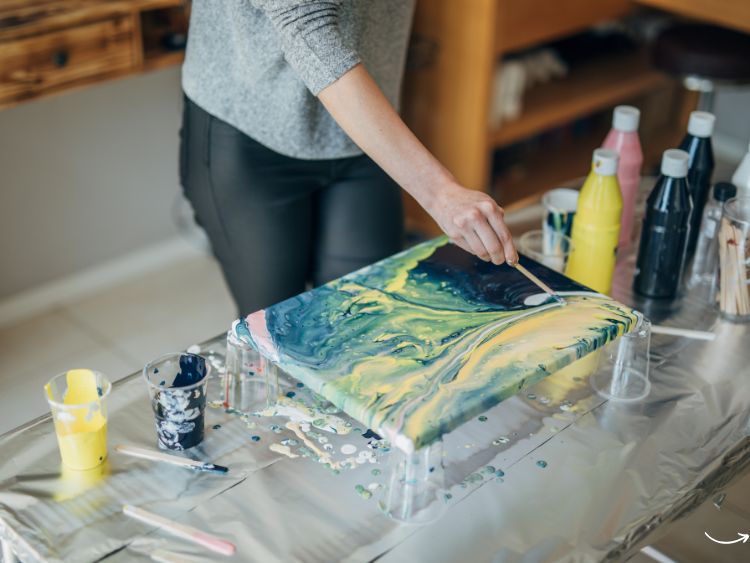Butterflies have long been symbols of transformation, beauty, and freedom. Their vibrant colors and delicate wings inspire awe and admiration. It’s no wonder that artists have been captivated by these winged wonders, translating their ethereal beauty into stunning works of art. Enter the world of butterfly painting—a delightful fusion of nature and creativity. In this article, we will explore the enchanting realm of butterfly painting, delving into techniques, inspirations, and the profound joy it brings to artists and enthusiasts alike.
The Allure of Butterfly Painting
Butterfly painting isn’t just about capturing the likeness of a butterfly on canvas; it’s about encapsulating the essence of these creatures and the emotions they evoke. The process of painting butterflies can be therapeutic, offering a meditative escape from the hustle and bustle of daily life. But what exactly makes butterfly painting so alluring?
A Dance of Colors
One of the most compelling aspects of butterfly painting is the opportunity to play with colors. Butterflies exhibit a dazzling array of hues, from the deep blues of the Morpho butterfly to the fiery reds of the Red Admiral. Artists can experiment with color palettes, blending shades to mimic the natural iridescence of butterfly wings. This dance of colors is not only visually pleasing but also stimulates creativity, pushing artists to think outside the box.
Capturing Movement
Butterflies are seldom still; they flutter and glide with an elegance that is both captivating and challenging to capture. Artists must master the art of portraying movement, using brushstrokes that convey the lightness and grace of a butterfly in flight. This dynamic element adds a layer of complexity to butterfly painting, making it a rewarding challenge for artists of all skill levels.
Techniques and Tips for Butterfly Painting
Whether you’re a seasoned artist or a beginner looking to dabble in butterfly painting, there are several techniques and tips that can help you create stunning artworks. Here are some key pointers to get you started:
Choose the Right Medium
Butterfly painting can be done using various mediums, each offering unique advantages. Watercolors are perfect for capturing the delicate translucency of butterfly wings, while acrylics and oils provide vibrant, long-lasting colors. Choose a medium that aligns with your style and the effect you wish to achieve.
Study Butterfly Anatomy
Understanding the anatomy of butterflies is crucial for creating realistic paintings. Study the wing patterns, body structure, and antennae of different butterfly species. Paying attention to these details will make your paintings more accurate and lifelike.
Experiment with Textures
Butterfly wings have intricate textures that can be challenging to replicate. Experiment with different brush techniques to create the illusion of texture. Dry brushing, stippling, and glazing are some methods that can add depth and dimension to your paintings.
Play with Backgrounds
The background of your butterfly painting can enhance the overall composition. Consider using contrasting colors to make the butterfly stand out or create a natural setting that complements the subject. Backgrounds can range from abstract washes of color to detailed depictions of flowers and foliage.
Embrace Creativity
While accuracy is important, don’t be afraid to let your creativity shine. Abstract interpretations of butterflies can be just as captivating as realistic ones. Use bold colors, exaggerated forms, and imaginative compositions to express your artistic vision.
Inspiring Themes in Butterfly Painting
Butterfly painting isn’t limited to realistic portrayals; it can encompass a wide range of themes and styles. Here are some inspiring themes to explore in your butterfly painting journey:
Nature and Nurture
Butterflies are often associated with flowers and plants, creating a perfect opportunity to blend botanical elements into your paintings. Depicting butterflies in their natural habitat not only adds context but also creates a harmonious composition.
Symbolism and Mythology
Butterflies hold significant symbolism in various cultures. They are often seen as symbols of transformation, rebirth, and the soul. Incorporate these symbolic elements into your paintings to add layers of meaning and storytelling.
Abstract and Surreal
Abstract and surreal butterfly paintings push the boundaries of traditional art. Play with shapes, colors, and forms to create dreamlike compositions that evoke emotion and intrigue. This style allows for maximum creative freedom, making each painting a unique expression of the artist’s imagination.
Mixed Media Magic
Combine different artistic mediums to create mixed media butterfly paintings. Incorporate elements like collage, ink, and even digital art to add texture and depth. Mixed media artworks offer endless possibilities for experimentation and innovation.
FAQs About Butterfly Painting
What materials do I need to start butterfly painting?
To start butterfly painting, you’ll need quality paints (watercolors, acrylics, or oils), brushes, a palette, canvas or watercolor paper, and reference images of butterflies. Additionally, having a good sketchbook and pencils for preliminary sketches can be helpful.
How can I improve my butterfly painting skills?
Practice regularly and study real butterflies to improve your skills. Observe their wing patterns, colors, and movements. Experiment with different techniques and seek feedback from fellow artists or join art classes to refine your skills.
Can I paint butterflies from photographs?
Yes, painting from photographs is a common practice. Choose high-quality reference images that capture the details and colors accurately. Use these photos as a guide while infusing your own creativity into the painting.
Is butterfly painting suitable for beginners?
Absolutely! Butterfly painting can be a great starting point for beginners. Start with simple sketches and gradually work your way up to more detailed paintings. The key is to practice and enjoy the process.
What are some common mistakes to avoid in butterfly painting?
Common mistakes include using muddy colors, neglecting the symmetry of butterfly wings, and overlooking the importance of background elements. Take your time to plan your composition and use a clean palette to mix vibrant colors.
Conclusion
Butterfly painting is a mesmerizing blend of nature’s beauty and artistic expression. It invites artists to explore the vibrant world of colors, patterns, and textures, all while honing their skills and nurturing their creativity. Whether you’re painting a realistic Monarch butterfly or an abstract, whimsical creation, the process is as rewarding as the final artwork.
So, pick up your brushes, let your imagination take flight, and embark on your butterfly painting journey. Remember, in the world of art, there are no limits—just endless possibilities waiting to be explored. Happy painting!
Authoritative Links
For further reading and inspiration, here are some authoritative links related to butterfly painting:
By incorporating these elements into your article, you can ensure it is informative, engaging, and optimized for SEO.




